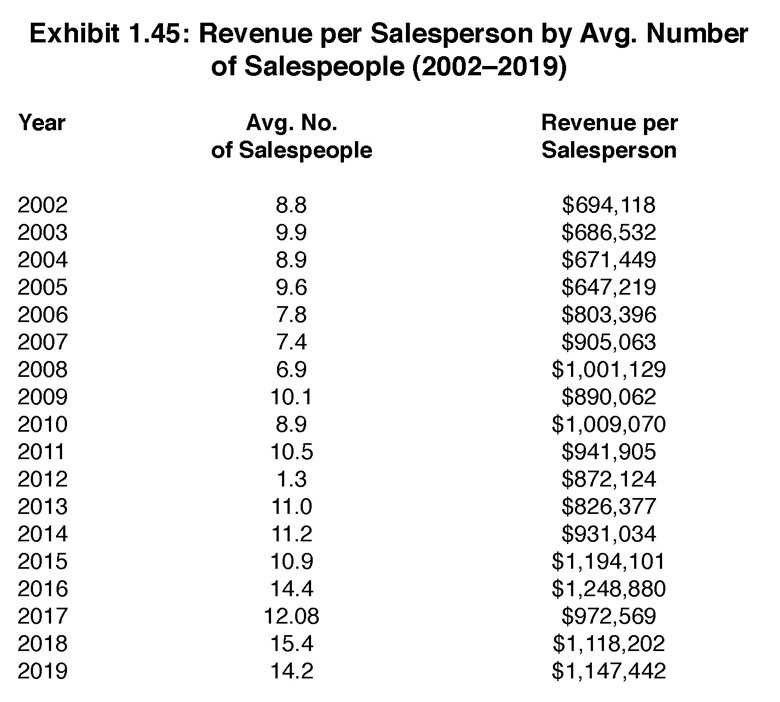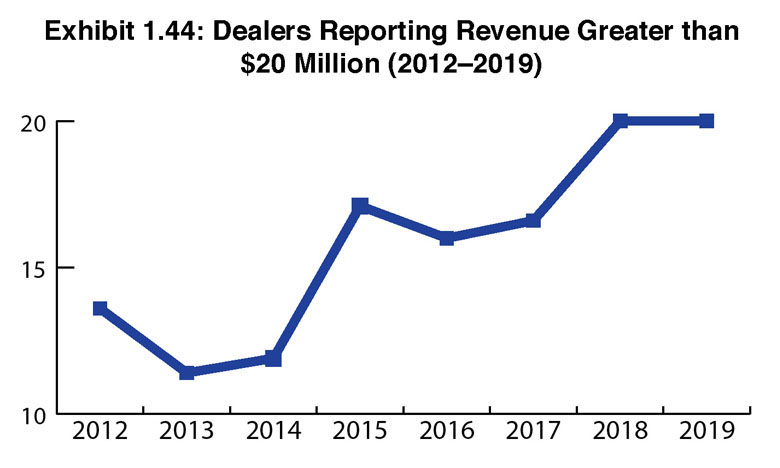The flow of private-equity money into the channel continued unabated throughout 2018. Meanwhile, mid-sized and larger, well-funded dealers expanded their regional footprints through acquisitions. After the acquisition of DEX Imaging Group by Staples in January of this year, we expect to see that organization, which we still view as a significant player in the channel, drive more acquisitions and raise the bar even higher in terms of revenue and productivity.
An indication of just how big dealers are getting can be seen in Exhibit 1.44, which tracks dealers reporting revenues of greater than $20 million from 2013 to 2019. Last year, that figure rose to 23% from 17% the previous year. However, that figure fell to 20% in this year’s Survey. We believe that the low twenties is about right for the percentage of dealers with revenues of $20 million or greater and don’t consider the 3% change decline (can that be changed to drop since you use downward at the end of the sentence? a sign that dealers with revenues of $20 million-plus are trending downward. More intriguing is what’s been happening since our 2013 Survey when dealers reporting revenues of greater than $20 million fell to about 11% from 14% in 2012. Since 2014, that percentage has ranged between 17% and 23%, which we believe is a sign of a healthy channel.
To better understand how revenue impacts productivity, we take total dealer revenue and divide it by the total number of salespeople (Exhibit 1.45). We do not distinguish revenues from other sources such as supplies and services. As shown in the Survey, the increase in productivity is consistent with the increase of average revenue per dealer even with the price erosion that’s been impacting the channel.
We also combine the “other” salespeople who were responsible for selling MPS and MNS with hardware salespeople. In a growing number of dealerships, hardware reps are tasked with selling MPS, and increasingly more reps are also responsible for MNS although that is not usually the situation in larger dealerships with MNS divisions. This year, the average number of salespeople combining traditional sales reps with MPS and MNS reps was 14.2, down from 15.4 a year ago. We attribute the decline to greater participation among smaller dealerships in our Survey. If we were only to include traditional hardware sales reps, that figure would be 12.5, not much different from what it was last year (12.8).
Please note that we continue to analyze this data differently than most surveys conducted by and for the independent dealer channel. Our intent is to present a simple way to measure sales productivity and the correlation between the size of a dealer and revenue. We remain confident this method of analysis offers an accurate barometer, particularly when we speak to companies and vendors that have an interest in marketing their products through dealers.
Our method of analysis broaches the question of which analytical approach is more accurate or most appropriate for tracking productivity. By including “other” sales or support people as an option, we believe the data more accurately reflects the relationship of dealer sales to revenue. One may argue this could negate the value of our trending perspective, but in our view this method still best reflects the evolving dealer business model even as the overall number of MPS and MNS sales support staff trends downward.
After two consecutive years of seeing revenue per salesperson exceed $1 million, that figure fell to $972,569 in 2017’s Survey. Last year, that figure broke the $1 million mark again, and was over the $1 million threshold again this year.
We continue to hear that hardware placements are trending downward, and if that is truly happening, sales reps seem to be finding other ways to increase the revenue they are bringing in for their dealerships. We’re skeptical that new technologies are currently driving those increases. Could it be that MPS and MNS revenues are responsible? Possibly with MPS, but we keep hearing anecdotally how dealers are struggling to make money with MNS, even if our Survey suggests otherwise. If we had to make an educated guess, it would be that A3 hardware placements have yet to fall completely off the rails. However, sales reps should still start preparing themselves for a future where more customers realize they no longer need A3 or as many A3 devices as they had in the past.
Access Related Content
Visit the www.thecannatareport.com. To become a subscriber, visit www.thecannatareport.com/register or contact cjcannata@cannatareport.com directly. Bulk subscription rates are also available.




